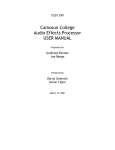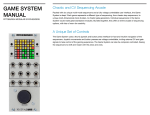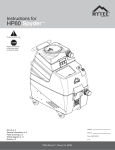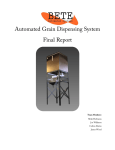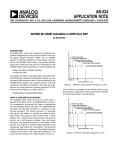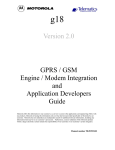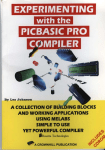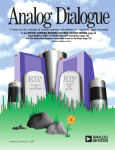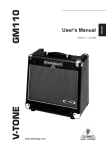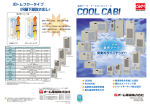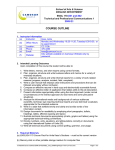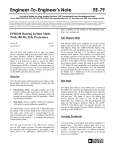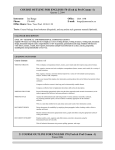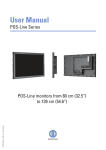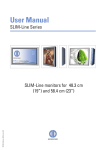Download Camosun College Audio Effects Processor
Transcript
ELEX 290 Camosun College Audio Effects Processor Prepared for Godfried Pimlott Joe Benge Prepared by Darryl Gamroth Simon Tipler March 10, 2001 March 16, 2001 Godfried Pimlott Joe Benge Camosun College Dear Mr. Pimlott and Mr. Benge I am enclosing our report Camosun College Audio Effects Processor as requested. Sincerely Simon Tipler Enc ii Executive Summary The Camosun College Audio Effects Processor allows the User to easily add “effects” to their music or clean a noisy signal. With a simple User Interface and many effects with extreme customization features, this processor surpasses the competition. Using a DSP processor, all mathematical calculations are very quick to render pristine sound quality. Also, the User Interface is ridiculously simple with a clear graphical display and a single Control Knob with push button. This knob controls all variables and navigation allowing the musician to make quick changes and get back to enjoying their music. iii Table of Contents 1.0 CONCEPT............................................................................1 1.1 Understanding this Report.....................................................1 1.2 Background ......................................................................1 2.0 DISCUSSION .........................................................................2 2.1 Product Description ............................................................2 2.2 Hardware.........................................................................2 2.2.1 ADSP-2181 EZ Kit Lite.....................................................2 2.2.2 PIC Microcontroller........................................................5 2.2.3 Input / Output devices ...................................................6 2.2.3.1 LCD Display............................................................6 2.2.3.2 Control Knob ..........................................................7 2.2.3.3 Presets.................................................................8 2.2.4 Components ................................................................8 2.3 User Interface and Interaction................................................9 2.4 Effects .......................................................................... 10 2.4.1 Passthru................................................................... 10 2.4.2 Dirty Distortion .......................................................... 10 2.4.3 Cool Chorus............................................................... 10 2.4.4 Rad Reverb ............................................................... 10 2.4.5 Phun Phasor .............................................................. 10 2.4.6 Funky Flange ............................................................. 10 2.4.7 Demon Delay ............................................................. 11 2.4.8 Power Pitch .............................................................. 11 2.4.9 Fierce Filter .............................................................. 12 2.5 Cost ............................................................................. 13 3.0 CONCLUSION...................................................................... 13 4.0 GLOSSARY of TERMS ............................................................. 14 5.0 REFERENCES ...................................................................... 16 6.0 APPENDICES ...................................................................... 17 6.1 Schematic ...................................................................... 17 6.2 Top Layer PCB ................................................................. 18 6.3 Bottom Layer PCB............................................................. 19 6.4 User Interface Top Level State Machine................................... 20 6.5 User Interface Controller Source Code .................................... 21 6.6 DSP Source Code .............................................................. 22 iv List of Figures Figure Figure Figure Figure Figure Figure Figure Figure 1: 2: 3: 4: 5: 6: 7: 8: Physical Layout .................................................................2 Effects Building Blocks ........................................................3 Delay Effect.....................................................................3 Reverb Effect ...................................................................4 Chorus, Flange, Pitch, and Chord Effect ...................................4 Modulator used for Vibrato and Distortion .................................4 Phasor using a variable frequency notch filter ............................5 Direction state machine for the Control Knob .............................7 List of Tables Table 1: The scale ....................................................................... 11 v Camosun College Audio Effects Processor 1.0 CONCEPT This report will introduce the reader to the Camosun College Audio Effects Processor including descriptions of the unit, input/output requirements, User Interface and controls, and the effects. 1.1 Understanding this Report The simple menus system accesses all of the options for this system. To further understand the navigation system, read the Camosun College Audio Effects Processor USER MANUAL. When this report describes the use of each effect, we assume the reader is familiar with the basics of musical terminology. The Glossary of Terms includes definitions of most terms in this report. 1.2 Background Guitar effect processors are commonplace in the music industry with nearly all guitarists using some type of guitar pedal to alter the sound from their guitar. Since the 60’s, guitar pedals have improved with better sounds and more options for the musician. Leaders in this huge industry include BOSS, Digitech, Ibanez, and others. Currently, multi-effect pedals have hundreds of effects with fantastic customizability, but their price is beyond the amateur guitarist’s budget. That is not the only problem. What about people who play the flute, oboe, or saxophone? What about DJ’s using turntables? There are many instruments, beyond guitar, that can use an effects processor. The User only requires only a microphone and preamp. The Camosun College Audio Effects Processor improves the sound of any instrument. 1 2.0 DISCUSSION 2.1 Product Description This unit has stereo input and output channels, a Power Connector Port, simple controls, and many customizable audio effects enclosed in a beige case. Figure 1: Physical Layout 2.2 Hardware The entire Camosun College Audio Effects Processor consists of four parts: 1. ADSP-2181 EZ Lab demo board from Analog Devices 2. PIC16F877 Microcontroller from Microchip 3. Various User I/O devices 4. Control components 2.2.1 ADSP-2181 EZ Kit Lite The ADSP-2181 EZ Kit Lite is a powerful inexpensive evaluation platform for the ADSP-2181 DSP. We chose this platform due to its on board AD1847 SoundPort CODEC. This is a full duplex 16 bit stereo CODEC capable of sampling at 48 kHz, ideally suited for our project. Unfortunately, this part is no longer in production; therefore, we could not produce a commercial product using this 2 part. The ADSP-2181 is a 16 bit fixed point digital signal processor running at 33 MHz, it is adequate for our current incarnation of the effects processor but has several quirks. All of the effects are processed in the time domain. As all effects are time based, they each share the same fundamental building blocks. The base block for the majority of the effects is the delay line. The delay line puts an input sample into memory, which is recalled later to produce a delay. To create reverb we feed the output of the delay back into its input, which causes an echoing sound. This echo will continue forever if the gain is equal to one. Delay by D samples Add Z-D Variable Delay Multiply Gain x Figure 2: Effects Building Blocks All effects are constructed using these building blocks as shown below: y (n) = x(n) + ax(n − d ) x(n) Z-d a Figure 3: Delay Effect 3 y (n) = x(n) + ay (n − d ) x(n) Z-d a Figure 4: Reverb Effect y (n) = x(n) + ax (n − d (n)) x(n) Z-d(n) d (n) a Figure 5: Chorus, Flange, Pitch, and Chord Effect As shown in Figure 5: Chorus, Flange, Pitch, and Chord Effect, we can modify the function d (n) as we see fit. In the chorus effect, the processor varies the delay from 20ms to 50ms at 0.25Hz. Flange is just a special case of chorus; delay varies from 0ms to a user specified amount and a selected frequency. Pitch scaling is a similar technique, except to drop and add samples to the playback buffer, we use saw tooth waveform. x(n) a y ( n) = a × x( n) × f ( n) f (n) Figure 6: Modulator used for Vibrato and Distortion 4 Distortion is achieved by modulating the input signal with either a sinusoid or a saw tooth wave. The output signal can be saturated by adjusting the gain. y (n) x(n) H(z) a Figure 7: Phasor using a variable frequency notch filter To implement phasor, the input signal is mixed with itself passed through a notch filter. This causes a phase shift in the output signal. 2.2.2 PIC Microcontroller The PIC Microcontroller from Microchip controls all User input and transmits all changes in data to the ADSP EZ Lab demo board. The User Interface uses the PIC16F877 for its multiple serial communication ports, speed, many input/output ports, built in timers, and availability of optimized C compilers. For this project, we use the Serial Peripheral Interface (SPI) to communicate with a digital potentiometer, the Analog Devices AD8400, discussed in the “Control Components” section. The PIC also runs at the maximum speed of 20MHz. By running at this speed, the PIC can quickly compute calculations, rapidly transmit data, and control many devices. Since current consumption is not a variable in this project because of the required power adapter, this warrants running at a faster speed. Since this PIC16F877 has 33 I/O pins, there are enough data lines for the parallel memory write, control, User input, and chip selection. Originally, there were not enough data lines for communication. To resolve this problem, the Toshiba TC74HC595 (SPI 8-bit shift register) could add eight more output lines. This device is incredibly useful because it only requires a chip select and the SPI data and clock lines, which the digital potentiometer already uses. After much rearrangement, and a change in a major component, this chip was no longer necessary. 5 Another purpose for the PIC Microcontroller is the “Interrupt on change” feature on PORT B for the Control Knob. We tested this feature; however, polling proved to be more effective. Using the “Interrupt on change” missed occasional step rotations, but polling never missed any changes. To compose code for the PIC16F877, we used the PCM C Compiler. This compiler is extremely efficient, and it is simple to use for writing strings of data to a device. To fit large programs, this compiler spends most of the compiling process rearranging code to fill banks on the PIC. Most compilers for PIC do not rearrange segments for optimum banking. To make compiled code more efficient, the complier optimizes both delays and complicated math routines. Another feature of the PIC processor family is the built in timers. These allow interrupts to occur determined by the programmer. The purpose for these timers in this project is to determine “timeouts” when waiting too long for a particular device to respond and to determine the rotation speed of the Control Knob. 2.2.3 Input / Output devices The Input / Output devices consists of three groups: 1. LCD Display 2. Control Knob 3. Preset Buttons Please refer to section 2.3, User Interface and Interaction, for more information regarding the use of the Camosun College Audio Effects Processor. 2.2.3.1 LCD Display The LCD for this project is the Optrex DMF50834 with a built using the NEC upd16435 controller distributed by Apollo Displays (www.apollodisplays.com). This product is ideal for this project for its multiple options and fast speed. Some of the built in functions are: Reverse Line Magnification (Double width, double height, or both double width and double height) Blinking character Cursor Backlight At the beginning of the project, the options were unknown; this made this LCD particularly advantageous. We considered using the backlight function, but 6 abandoned it because of its extreme sensitivity to small changes in voltage. In addition, the LCD for this project was inexpensive because of a broken backlight. To signify a selected item, we used the reverse line function. Our group felt this would unmistakably designate a selected item. The Graphical Display shows the User the vertical menu system and all submenus. This system is unbelievably User-friendly to navigate and edit settings. A reversed line designates the currently selected item on the LCD. Depending on the lighting in the environment, the User is able to digitally set the contrast in the Contrast menu item (see AD8400 in the Control Components). 2.2.3.2 Control Knob To simplify all User-interaction, the knob with integral push button controls the entire system. We chose a 32 detent Grayhill 61C11-01-08-02. The detents provide the User feedback to acknowledge single steps. There are only three wires to communicate to the PIC controller; two wires for the direction of rotation and the other wire provides the signal for the push button. Figure 8: Direction state machine for the Control Knob Since the PIC recognizes each step of the Control Knob, it is simple to determine the speed and direction of the rotation. Using one of the PIC’s built-in timers, we determined that a change within 190ms defines “fast” rotation. Any changes that take longer than this define as “slow” or “single step” rotations. We call this process, “velocity-controlled stepping” where fast rotations result in bigger changes in setting a variable. Steps for a fast rotation are groups of ten. With a 32 step knob, a full byte change is 256/(10*32) = 0.8 of a full rotation. We chose groups of ten because this is the greatest change possible for one to easily rotate the knob. 7 The problem with velocity-controlled stepping is looping a variable around zero. Stepping from 255 to zero (and backwards) seems more efficient than blocking the User at the maximum value. However, if turning the knob quickly, the User may pass a desired maximum value. To stop this, we turn OFF velocity-controlled stepping when the User is 20 steps from minimum and maximum values. This way, the User can still loop around, but not make an undesired mistake. 2.2.3.3 Presets To allocate the musician’s favorite effects to particular presets we use four Preset Buttons. These presets are simple Normally Closed (N/C) contacts. The reason for these particular buttons is they are both inexpensive and esthetically pleasing (they already have red buttons). 2.2.4 Components There are a few more parts of this processor: Power Connector Port Stereo input / output jacks AD8400 Digital Potentiometer 74HC138 Address Decoder K6T4008C1V 512kbyte SRAM Power Connector Port Since the processor consumes a substantial amount of current to provide ultimate sound clarity, it is not efficient to run this unit from batteries. Simply connect the included power adapter to the Power Connector Port, and you are ready to play! Stereo input / output jacks The audio input and output ports are ¼” stereo jacks. ¼” jacks are a standard in the music industry for their power handling abilities and cost of cable. AD8400 The AD8400 is a single 256 step digital potentiometer used for the contrast of the Graphical LCD. This part communicates using the SPI port allowing extremely fast changes. This allows the User to digitally set the contrast of their screen in the “Contrast” sub-menu. 8 We researched other digital potentiometers; however, the Analog Devices series provides different ranges (32 step, 64 step, 128 step, and 256 step). For contrast, many steps are required to achieve optimum contrast. Also, SPI communication is extremely simple and fast for a PIC Microcontroller. 74HC138 The 74HC138 address decoder splits the DSP’s 4MB addressable space into eight blocks of 512 kB. One decoder output selects the flash memory, and another selects the 512k of SRAM. We used this part rather than other address decoders simply because we used this part in studies at school. K6T4008C1V The K6T4008C1V from Samsung is low power, high speed SRAM. SRAM is required to provide a sufficient buffer for the digital data from the input signal. The reason for SRAM opposed to other high speed volatile storage is that our DSP requires SRAM. 2.3 User Interface and Interaction The entire interfaces consists of three parts: 1. Graphical Display 2. Control Knob 3. Four Preset buttons To enter a menu item, edit a number, exit number entry, etc., simply press the Control Knob into the unit. This way, speed of entry is extremely efficient, and the User does not have to search for multiple buttons. To define a particular preset, simply select the effect in the Main Menu, and press the chosen Preset Button. Immediately this effect processes the input signal. To vary the sound, enter that particular menu item and change the variables. The effect updates the sound in “real time”. This allows the musician to create very interesting sounds. To overwrite a particular preset, simply select a new effect and press the same Preset Button. Right away, the new effect will be associated with that Preset Button, and the unit will immediately run the new effect. For more information on User Interaction, please refer to the Camosun College Audio Effects Processor USER MANUAL. 9 2.4 Effects 2.4.1 Passthru Simply outputs the input signal with absolutely no processing on the sound. This is called a “Dry Signal”. 2.4.2 Dirty Distortion By increasing the amplitude of the input signal, eventually the signal will “clip”. Clipping is the process by which an AC signal increases past the stability point. The result is many high frequency components also known as “noise”. The User has full control over the level of noise. 2.4.3 Cool Chorus The Chorus effect allows the user to hear multiple instances of the input signal when each instance synchronizes with the others, except for small variations in their strength and timing. This means that one vocalist can sound up to three people singing the same thing. The User controls the number of “voices” heard with a maximum of three due to program space restrictions. 2.4.4 Rad Reverb Reverb is simply a Comb Filter. This effect occurs when a sound wave bounces off walls of a listening space, but has an interesting effect when there are multiple reflections. 2.4.5 Phun Phasor Phasing or phase shifting passes the signal through a narrow notch filter and combines a proportion of the filter’s output with the direct sound. To create a weird effect, the centre frequency of the notch filter varies in a controlled manner. The User sets this variable in the Phun Phasor Sub-Menu. 2.4.6 Funky Flange 10 The process of periodically varying the delay with a low frequency (such as 1Hz) is the Flange effect. This product allows the User to set both the period and the frequency of this sound. 2.4.7 Demon Delay Delay for our processor is really a tapped delay, which is really just a set of delays. Our system provides up to three separate delays of a signal at different gains. The User sets both delays and gains for the three “taps”. This allows plenty of variables for the musician to customize their sound. 2.4.8 Power Pitch The Power Pitch allows the User to “bend” the input signal in half step intervals up to one octave up or one octave down. An octave consists of 12 half step tones to create the “Equal Tempered Scale”. The scale based on fifths proposed by Pythagoreas (600BC) is the basis of the Equal Tempered Scale. Equal Tempered Scale (Chromatic Version) C C# D D# E F F# G G# A A# B C Ratio Interval Name Just Interval 1.0000 1.0595 1.1225 1.1892 1.2599 1.3348 1.4142 1.4983 1.5874 1.6818 1.7818 1.8877 2.0000 Unison Half Step Whole Step Minor Third Major Third Perfect Fourth Diminished Fifth Perfect Fifth Minor Sixth Major Sixth Minor Seventh Major Seventh Octave 1.0000 1.0667 1.1250 1.2000 1.2500 1.3333 1.4063 or 1.4222 1.5000 1.6000 1.6667 1.8000 1.8750 2.0000 Table 1: The scale The 12-tone equal tempered scale is a natural scale for electronic music systems because of the simplicity of equal valued steps. Though nearly impossible to audibly notice any difference, the musician must acknowledge this is only an approximation of the true Just Major Scale. 11 2.4.9 Fierce Filter To reduce high frequency noise from a particular input instrument, the Fierce Filter allows the user to remove high frequencies. The User is also able to set the cut-off frequency. 12 2.5 Cost DSP Board PIC SRAM Flash PCB Connectors LCD Knob Buttons Case Misc $132.00 $ 15.00 $ 32.00 $ 10.00 $ 10.00 $ 15.00 $ 50.00 $ 32.00 $ 10.00 $ 22.00 $ 20.00 Sub Total Provided Total $348.00 ($167.00) $181.00 Provided Provided Free Provided We completed this project significantly under budget. This is due to most of the expensive components supplied by the College. 3.0 CONCLUSION The Camosun College Audio Effects Processor provides the musician with several advantages over many other similar products: Line input! Not only for guitar Extremely simple User Interface with clear LCD display and few buttons Future expandability This chief disadvantage of this product is only in the number of effects. Future expansions of this product will allow for multiple inputs and more effects. 13 4.0 GLOSSARY of TERMS HARDWARE CODEC Hardware that performs analog to digital and digital to analog conversion. Includes signal conditioning circuitry Control Knob – large knob below the LCD. This is the main input device for the User. Control Knob Button – asserts when the Control Knob is pushed into the unit Control Knob Rotation – turning the Control Knob Full Duplex The ability to record and playback simultaneously Input Device Any audio source with a LINE output LCD The text display screen Output Device Any audio output device with a line input (ie Amplifier) Power Connector Port Requires minimum 7V at 200mA power adapter Preset Buttons Four red buttons to allocate particular effects to particular Presets MENU SYSTEM Main Menu The vertical list of particular options and effects. Sub-Menu The options for a particular item in the Main Menu. Sub-Menus are only for items containing options or information. AUDIO TERMINOLOGY Clip, Clipping overload, severe distortion 14 dB (decibel) a unit of measurement, ratio of two voltages (dB = 20log(V1/V2)) Dry Signal no processing of the input signal Filter device or program for adding or removing part of a frequency bandwidth Line Signal amplified signal within 100mV peak to peak produced by sound cards, turntables, etc. Mic (Microphone) Signal signal within 20mV peak to peak produced by guitars, microphones, etc. Wet Signal signal with effects added 15 5.0 REFERENCES 1. Analog Devices. ADSP-2100 Family – EZ-KIT Lite Reference Manual. Norwood, MA, 1995. 2. Analog Devices. ADSP-2100 Family – EZ-KIT Lite Evaluation Platform Data Sheet. Norwood, MA, 1998. 3. Behringer International. DX500 Pro Mixer USER’S MANUAL. Hanns-MartinSchleyer-Straße. D-47877 Willich, Műnchnëide ||, September 1998. 4. Hutchins, Bernie. Music for Electronic Engineers. Electronotes. Ithaca, New York, July 1975. 5. Orfanidis, Sophocles J. Introduction to Signal Processing. Prentice-Hall Signal Processing Series. Upper Saddle River, New Jersey, 1996 16 6.0 6.1 APPENDICES Schematic 1 2 3 4 6 5 Y1 4MHz +5V R1 1kOhm C4 0.1uF C1 0.1uF C3 18pF D 11 32 C2 18pF +5V D R2-5 1kOhm sim J1 PRESETS +5V 12 31 7 5 3 1 8 6 4 2 C 14 15 IAD0 16 IAD1 17 IAD2 18 IAD3 23 IAD4 24 IAD5 25 IAD6 26 IAD7 19 IAD8 20 IAD9 21 IAD10 22 IAD11 27 IAD12 28 IAD13 29 IAD14 30 IAD15 10 !CS_LCD PIC16F874-20/P(40) C8+5V OSC1/CLKIN OSC2/CLKOUT MCLR/VPPRC0/T1OSO/T1CKI RA0 RC1/T1OSI/CCP2 RA1 RC2/CCP1 RA2 RC3/SCK/SCL RA3 RC4/SDI/SDA RA4/T0CKI RC5/SDO RA5/SS RC6/TX/CK RB0/INT RC7/RX/DT RB1 RD0/PSP0 RB2 RD1/PSP1 RB3 RD2/PSP2 RB4 RD3/PSP3 RB5 RD4/PSP4 RB6 RD5/PSP5 RB7 RD6/PSP6 RE0/RD//AN5 RD7/PSP7 RE1/WR/AN6 RE2/CS/AN7 VSS VSS 13 1 !IWR 2 !IACK3 IAL 4 !IS 5 6 !IRD 7 PRESET0 33 PRESET1 34 PRESET2 35 36 PRESET3 37 38 39 !IRQL0 40 !DSPRESET8 9 +5V VDD VDD U1 LCD_RS LCD1 !CS_LCD !IRD !IWR +5V Vdrive R6R7R8 1kOhm 0.1uF U2 +5V 1 2 !DPOT_CS 3 4 SW1 6 5 4 3 2 1 V++ OUTA OUTB PB SW2 PB SW1 GND 6 5 4 3 2 1 OUTA OUTB SW2 B1 CLK GNDVDD !CS W1 SDI A1 5 6 7 8 J3 A0 A2 A4 A6 A8 A10 A12 U5 +5V 16 A B C Y0 Y1 Y2 Y3 G1 Y4 G2A Y5 G2B Y6 Y7 SN74LS138 VCCGND 15 !FLASH_CS 14 !SRAM_CS 13 12 11 10 9 7 8 C5 +5V D0 D1 D2 D3 D4 D5 D6 D7 A 22 !FLASH_CS CE !RD 24 OE 31 WE 1 VPP 28F010 13 D8 14 D9 15 D10 17 D11 18 D12 19 D13 20 D14 21 D15 U4 A012 A111 A210 A3 9 A4 8 A5 7 A6 6 A7 5 A827 A926 23 A10 25 A11 A124 28 A13 A143 31 A15 A162 30 A17 A181 A0 A1 A2 A3 A4 A5 A6 A7 A8 A9 A10 A11 A12 A13 A14 A15 A16 A17 A18 22 !SRAM_CS !CS 24 !RD !OE 29 !WR !WE VCC VCC A0 A1 A2 A3 A4 A5 A6 A7 A8 A9 A10 A11 A12 A13 A14 A15 A16 GND 0.1uF C7 0.1uF U3 A012 A111 A210 A3 9 A4 8 A5 7 A6 6 A7 5 A827 A926 23 A10 25 A11 A124 28 A13 29 A14 A153 A162 D0 D1 D2 D3 D4 D5 D6 D7 13 D8 14 D9 15 D10 17 D11 18 D12 19 D13 20 D14 21 D15 D8 D10 D12 D14 A14 A16 A18 A20 !WR 1 3 5 7 9 11 13 15 17 19 21 23 25 27 29 31 33 35 37 39 41 43 45 47 49 C J2 A1 A3 A5 A7 A9 A11 A13 2 4 6 8 10 12 14 16 18 20 22 24 26 28 30 32 34 36 38 40 42 44 46 48 50 1 3 5 7 9 11 13 15 17 19 21 D9 23 D11 25 D13 27 D15 29 A15 31 A17 33 A19 35 !DSPRESET A21 37 !RD 39 !BMS 41 43 45 +5V 47 49 IAD1 IAD3 IAD5 IAD7 IAD9 IAD11 IAD13 IAD15 !IACK !IS !IRD +5V HEADER 25X2 2 4 6 8 10 12 14 16 18 20 22 24 26 28 30 32 34 36 38 40 42 44 46 48 50 IAD0 IAD2 IAD4 IAD6 IAD8 IAD10 IAD12 IAD14 B IAL !IWR !IRQL0 HEADER 25X2 A GND C6 0.1uF 32 +5V 32 +5V A19 1 A20 2 A21 3 +5V 6 !BMS 4 5 01 !CS_LCD 02 LCD_RS 03 !LCD_RD 04 !LCD_WR 05 D0 06 D1 07 D2 08 D3 09 D4 10 D5 11 D6 12 D7 13 !BUSY 14 !RESET 15 SCR 16 V+ 17 GND 18 Vdrive 19 GND 20 Vbackligh AD8400 Optical Switch B 1 2 3 4 5 6 7 8 9 10 11 12 13 14 15 16 17 18 19 20 SupaDupa Audio Processor Title 16 16 K6T4008C1B Size Number Revision B Date: File: 1 2 3 4 5 21-Mar-2001 Sheet of C:\Documents and Settings\dgamroth\My Drawn By: Documents\Effects Processo 6 17 6.2 Top Layer PCB 18 6.3 Bottom Layer PCB 19 6.4 User Interface Top Level State Machine 20 6.5 User Interface Controller Source Code See hard copy. 21 6.6 DSP Source Code See hard copy. 22




























